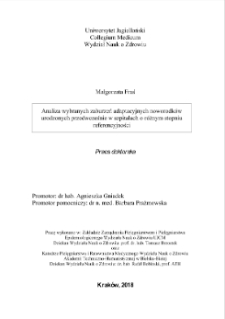Obiekt
Tytuł: Analysis of selected adaptation disorders in preterm infantsin hospitals of various reference levels
Abstrakt:
Background Despite of systematic improvement in the scope of health care, an increase of the percentage of preterm births has been observed, especially in developed countries. The largest and the most quickly growing group of preterm births are those occurring between the 34th and the 36th weeks of pregnancy, i.e. late preterm births (LPB). It is estimated that the number of late preterm infants (LPI) born between the 34th (0/7) and the 36th (6/7) weeks of pregnancy may constitute even 2/3 of all the preterm births in Poland.Due to shorter intrauterine development, infants from late preterm births are not fully mature therefore they are exposed to a higher risk of disorders in the infant adaptation period. Aim of the studyThe aim of the study was the assessment of adaptation disorders in infants born preterm between the 34th (0/7) and the 36th (6/7) weeks of pregnancy in hospitals of various referral levels. Material and methodsThe studies were conducted from June 2013 to October 2015 in three hospitals of various reference levels. The study group consisted of the medical documentation of 300 infants born preterm [between the 34th (0/7) and the 36th (6/7) weeks of pregnancy (LPI)] and of 300 infants born on the due date [between the 37th (6/7) and the 39th (6/7) weeks of pregnancy control group (CG)] in the period from January 2010 to December 2013.The studies applied a retrosp ; ective analysis performed by analysing the individual medical documentation of infants. The tool according to which the information related to the infants was put in order was an own Form for analysing the documentation of an infant born preterm. The statistical analysis of the data was performed using the STATISTICA 12.0 PL (StatSoft, Polska) package. Descriptive statistics methods were used for the presentation of results related to the quantitative variables.The analysis of the significant differences between mean values in the compared groups was performed using the Shapiro-Wilk and Levene's. Non-parametric tests were applied during the verification of hypotheses: the Mann-Whitney U test, the Kruskal–Wallis H test, contingency tables and the Chi-square test (χ2). Level of α= 0.05 were considered significant in all analyses. ; Results There were 57.0% (n=171) of infants born in the 36th week of pregnancy, 29.3% (n=88) of infants born in the 35th weeks of pregnancy and 13.7% (n=41) of infants born in the 34th week of pregnancy. It was demonstrated that LPI were more frequently born in surgical labours through a C-section (53.4%; n=166). In the CG there were more natural labours (66.7%; n=200). Complications to the course of the current pregnancy occurred in over a half of LPI mothers – 52.3% and in only 25.6% of mothers of infants from the CG. Premature rupture of membranes s ; ignificantly more frequently constituted the reason for the completion of the pregnancy in the group of LPI than in the CG (χ2=21.195; p<0.001). Infants born between the 34th and the 36th weeks of pregnancy demonstrated lower birth weight and body length as well as a lower circumference of the head and of the thorax more frequently than infants from the CG (p<0.001). Apgar score assessment in every measured minute of preterm infants were found to demonstrate values on average by 1 point lower than infants from the CG (p<0.001). Late preterm infants statistically significantly more frequently did not start the spontaneous breathing activity (χ2=46.320; p<0.001) and they required resuscitation (χ2=18.557; p<0.001) and respiratory support after birth more frequently than infants born on the due date. All the infants from the CG breathed spontaneously after being born.The main reason for postponing the vaccinations the hepatitis B virus (HBV) and tuberculosis (BCG vaccine) in preterm infants was low birth weight, IRDS and an intrauterine infection (χ2=72.019; p<0.001). The higher the reference level of a hospital the more frequently near-term infants were born there with also more frequently occurring perinatal complications (χ2=16.045; p=0.013) i.e.: intracranial haemorrhages, asphyxia and hypoxia; also in these hospitals rhesus incompatibility (χ2=9.078; p=0.010), respiratory sys ; tem infections (χ2=20.031; p<0.001), IRDS (χ2=7.835; p=0.019) and infant jaundice (χ2=7.342; p=0.025) were diagnosed more frequently, the saturation was monitored more frequently (χ2=16.563; p<0.001) and infant observation in an incubator was performed more frequently (χ2=9.750; p=0,007). Conclusions1. Infants born between the 34th (0/7) and the 36th (6/7) weeks of pregnancy demonstrated difficulties in adaptation to extrauterine life and health problems more frequently than infants born on the due date. 2. The found factors which significantly more frequently hindered the adaptation processes of LPI included: thermoregulation disorders, pathological jaundice, the infant respiratory distress syndrome (IRDS) and intrauterine infections.3. The immaturity of the gastrointestinal tract of LPI influenced the delay in introducing natural feeding.4. In LPI with adaptation disorders protective vaccinations were deferred more frequently than in children born on the due date.5. The extension of the hospitalization period of infants born between the 34th (0/7) and the 36th (6/7) weeks of pregnancy was caused by: intracranial haemorrhages, IRDS, intrauterine infections, infant jaundice and antibiotic therapy.6. The hospital reference level had an influence on the birth frequency of LPI, on the diagnosing process and on higher qualified medical care.
Miejsce wydania:
Stopień studiów:
Dyscyplina:
Instytucja nadająca tytuł:
Promotor:
Gniadek, Agnieszka ; Prażmowska, Barbara
Data wydania:
Identyfikator:
Sygnatura:
Język:
Prawa dostępu:
Kolekcje, do których przypisany jest obiekt:
Data ostatniej modyfikacji:
13 mar 2023
Data dodania obiektu:
15 kwi 2019
Liczba wyświetleń treści obiektu:
12
Liczba wyświetleń treści obiektu w formacie PDF
0
Wszystkie dostępne wersje tego obiektu:
http://dl.cm-uj.krakow.pl:8080/publication/4261
Wyświetl opis w formacie RDF:
Wyświetl opis w formacie OAI-PMH:
| Nazwa wydania | Data |
|---|---|
| ZB-128498 | 13 mar 2023 |
Obiekty
Podobne
Analysis of selected adaptation disorders in preterm infantsin hospitals of various reference levels
Fraś, Małgorzata
Ossowski, Piotr
Huras, Hubert
Ostrogórska-Gonszewska, Patrycja

